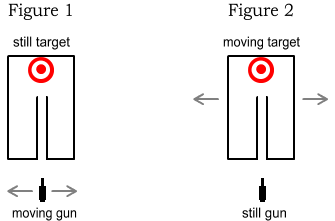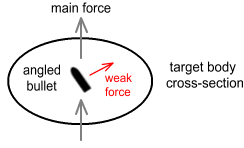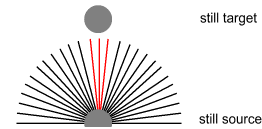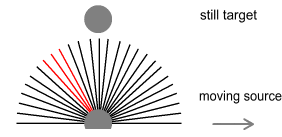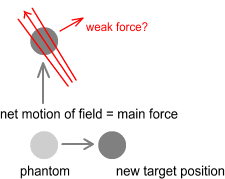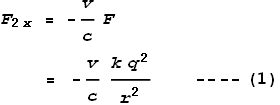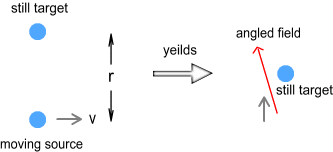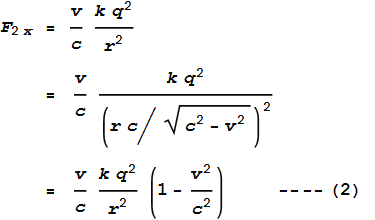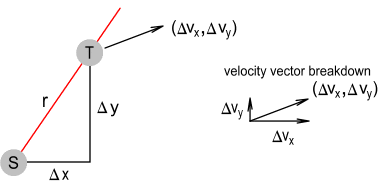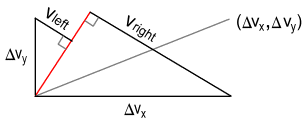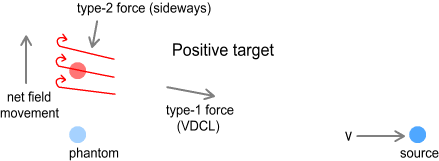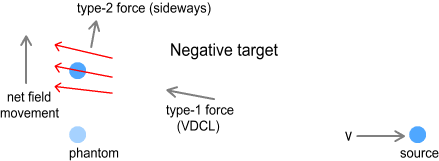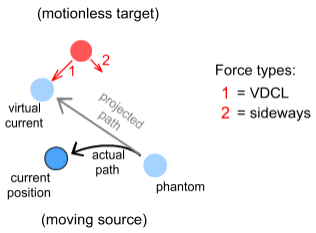The Sideways Force – part 2
The Hit Man ReturnsIn an earlier chapter on the Lorentz Transform
we looked at a derivation of that function involving the problem of a hitman taking down a
target in a drive-by shooting. Let’s now consider a variation on that. In this new
situation it will be necessary for the hitman to shoot the target several times. This time
road is not busy but, for some unexplained reason, the car is still not able to stop
directly in front of the target. So the driver needs to drive forward-and-reverse in front
of the property several times while the hitman does his job.
In Figure 1 (left) we see the target motionless and the hitman moving. For
simplicity the target is shown inside a box and at the end of a narrow tube. The walls of
this tube will absorb, rather than deflect, bullets. As before the hitman can hit the
target by aiming his gun at an angle to compensate for his left/right movement. So long as
the car is moving slower than the bullet, there will be no problem in selecting an
appropriate angle.
Which electron is moving?The above scenario seems odd as it appears to contradict the notion that velocity is relative. There is an analogous situation involved with charged particles. See below.
Two electrons are positioned above and below each other, a large distance
apart. In Figure 3 (left) the bottom electron stands still while the top electron zigzags
left and right. In Figure 4 (right), the situation is opposite: the top one stands still
while the bottom one zigzags. We wish to know the force experienced by the top electron in
each case.
Radio transmissionThe above situation creates a dilemma because it conflicts with our
experience of radio transmission. When electrons move up & down a transmission
antenna, they cause a similar movement of electrons in a distant receiving antenna. This
indicates the electrons in the receiver are experiencing some sort of sideways force
caused by those in the transmitter.
The angled bulletLet’s return to the original hitman scenario from the earlier chapter. The hitman angled his gun to exactly negate the
forward car-movement. Consequently the bullet moved at a 90 degree angle to the car and
hit the target head-on. According to our sideways force law, force must be in the same
direction and thus the bullet could not exert any sideways force.
Above we see a cross-section of the bullet moving through the
victim’s body. The bullet is moving vertically (relative to this page) but is doing
so on an angle. As the bullet moves forward we would expect that its orientation would
push the body not only forward but to the right. What we have in effect is a form of
sideways force in the direction of the car.
Above we see field lines extending from a source particle (bottom) toward
a target particle (top). Both particles are stationary. The lines extend from the source
in all directions but, since neither particle is moving, only the lines moving directly
upward (marked in red) hit the target.
Here the lines that ultimately hit the target are those that emerge at an angle (shown above in red). Just like the hitman’s bullet, the backward horizontal component of field velocity must match the forward velocity of the source particle. These field lines will then move directly upward and strike the target as shown below.
Just like the bullet then, it might be supposed that the edge of these field lines causes a force toward the right and slightly upward. This would explain how electrons in a receiving antenna are able to imitate the movement of those in a transmitter – even at great distances.
Type-1 and Type-2What we are describing here is a new kind of sideways force, and one distinctly different from the force described in the previous chapter. For the sake of distinction I’ll call this new force a ‘type-2 sideways force’, and the other one (from the previous chapter) a ‘type-1 sideways force’.
Calculation for simple situationsLet’s now derive some equations that describe the amount of type-2 sideways force in simple situations. We’ll start with two negative charges, directly above and below each other, as shown below.
They both have a charge of q, are separated by a distance
of r, the bottom charge is still and the top one is moving to the left
with velocity v. Here the target moves into a vertical field line (see
right). As a result it experiences a backward force to the right.
Where F2x is the type-2 sideways force in the x
direction. The velocity is expressed as a fraction of light speed and the minus sign shows
the force direction is opposite to velocity, so in this case the force is to the right.
This field line is moving directly upward but its angle gives it an effective horizontal velocity which is equal to the source velocity (v). The upward velocity is less than light speed which means that it takes longer to reach the target and hence will be weaker. Refer to the segment on phantom particles (in point 2). If we know the time taken we can determine the field strength by replacing distance r with c t. To determine the time we need to know the upward velocity. See below.
In the above diagram, the field line that hits the target must travel backward from the source particle with a horizontal velocity of -v. Using pythagoras we determine the upward component cy to be:
The time taken t can be determined by dividing distance r by this velocity:
Thus replacing r with c t yields:
Following from equation (1) the sideways force becomes:
As can be seen, this is very similar to (1), just slightly weaker.
Sideways force for opposite chargesWhat about the type-2 sideways force for opposite charges? Since we are speculating, the simplest approach is to suggest that the force direction will be reversed. This will give a promotional force; much like the type-1 sideways force does with opposite charges. Thus we remove the negative sign in front of the equation. This will automatically happen once we replace the q2 with the standard q1 times q2: the force becomes promotional when q1 and q2 have opposite signs.
Generic equation for the sideways forceNow to determine an equation that defines the type-2 sideways force in a more general situation. To do this we’ll make use of the situation with two charged particles in the previous chapter.
To simplify, the derivation here is based from the perspective of the source not moving, which means its position is also the phantom position and we only need refer to differences in velocity and position. Our first task will be to determine the sideways direction of velocity relative to an imaginary straight line connecting the two particles. See below.
By using proportional triangles we can determine the left and right components of velocity to be:
The net component of sideways velocity to the right of this line will be:
We now need to extract the x and y components of this net velocity according to the below diagram.
Again we can use proportional triangles to determine to determine these components. In this case the triangle has a different orientation so the reverse distance ratios are used:
[See a three-dimensional form of (3) and (4) here.] vnet-y has a negative sign because it is pointing downward. From this we can determine the net force in each direction:
Where F is the standard Coulomb force, namely:
Notes:
Rethinking the Type-1 forceBased on the discussion so far, what we now have are two sets of forces that can push charged particles sideways relative to a source particle’s position. Both type-1 and type-2 work in the same direction, hence they don’t conflict. And yet it seems redundant to have both types. Not that redundancy means they can’t both exist, but there is certain situation in which the type-1 force defies credibility.
Above we see two particles: a target particle above and an electron below.
The electron is moving to the right at 99% the speed of light. Its phantom image is
directly below the target and, due to the great speed, its current position is far to the
right. We wish to calculate the type-1 force on the target in two situations: when the
target is negative and when it is positive.
Here we see the field moving directly upward but angled in the direction
in which it was originally emitted. The U-turn occurs along this field direction and
points back toward the current position of the source particle.
Here there are no U-turns and the directions for both types of forces are
reversed.
The Virtual Current particleGiven the above observations it will be very helpful to introduce a new
concept: the ‘virtual-current particle’. It is defined as follows:
Much like the phantom particle, the virtual-current particle represents a hypothetical position of a source particle used in determining electric forces. The virtual-current particle is useful because it can be substituted directly into the VDCL and sideways force equations. Once we know its location we no longer need to concern ourselves with phantom positions or the time-decay of fields: the equations automatically cater for it. This doesn’t mean the phantom is now unimportant because we need to know its position in order to determine the virtual-current position. The steps for determining these hypothetical particle positions go like this:
No doubt these instructions seem daunting, and they certainly are. Other
than for simple geometric situations, these steps are best suited for a computer to crunch
numerically as they can be quite involved (especially step 2).
Calculating the total force (both types together)To calculate the net force on a charge, calculate the VDCL and the new
(type-2) sideways forces separately and then add them together.
Where [q1 q2] represents the sign (+ or -) of the charges multiplied together, and vt is the velocity of the source particle toward the target. vt can be given by this expression:
We can then split this force into its x and y components:
If desired we could instead redefine the field velocity as vf = c+vt and modify the force equation to include a -2c term for pull forces, as per the previous chapter. This would make the equation consistent with the U-turn model for pull forces. But on a practical basis, it is probably easier to express it in its above forms (7), (8) and (9). Equations (8) and (9) must then be added to (5) and (6) to calculate the net force in the x and y directions.
ConclusionThe net electric force on a charged particle can be calculated as a
combination of two separate forces. The first of these will be along the direction in
which the field was originally emitted from a source charge. For like charges the strength
of this force will be proportional to the cube of the field velocity. |
